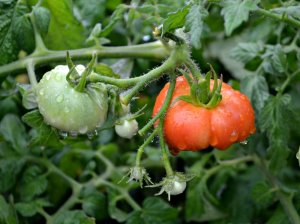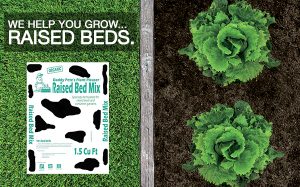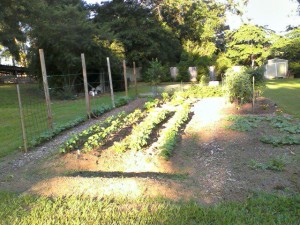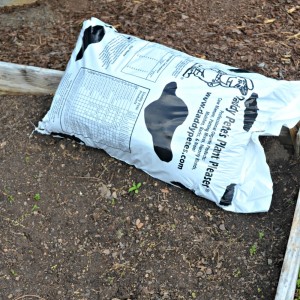Starting a Vegetable Garden: Part 1
Starting a Vegetable Garden from Scratch – Part One
Starting your first vegetable garden isn’t as hard as you might think. All it takes is a sunny spot in the yard, a few tools, a little planning and yes, a little hard work and sweat too. But in the long run, growing your own veggies is a very rewarding experience and well worth all the effort you put into it.

I am breaking this article down into two parts because it is a very “in depth” subject. Part One is all about the selecting your site, preparing your soil and the tools you will need. Honestly, this is the most important and time consuming part of the whole project. Part Two will be all about the plants from selecting them to harvesting them.
Choose your site. The amount of sunlight is very important in picking out the proper placement of your garden. Vegetables are sun lovers. You will want an area that gets 6 -8 hours or more of direct sunlight each day. Something else to take into account is the drainage of the land. You will not want your garden in a depressed area of land because water will tend to flood those areas and won’t drain properly. Veggies don’t like their roots to sit in saturated soil. I prefer using a slightly sloped piece of land or a flat piece of land that retains and drains water properly. How big should you make your garden? My first recommendation is to start small. Unless you have your heart set on space hogs like corn, start with a manageable sized garden. 12 X 20 should give you plenty of variety. You can always enlarge it next year.

The next thing to consider when choosing your site is accessibility to a water source and well as your kitchen. Vegetables need water on a regular schedule. If they get watered erratically they will exhibit all sorts of problems, like cracking open, not setting any fruit or becoming prone to cultural problems like blossom end rot. Proximity to the kitchen or at least from some entrance to the house will help you remember to water and check on your garden everyday and you will be more tempted to run out and pick something fresh while you’re cooking. Once you have chosen the location and size of you garden you will want to mark the boundaries of the garden with stakes or flags.
Soil. Next, let’s talk about the soil. Soil is the most important factor in any garden and perhaps more so in a vegetable garden. Almost all vegetables are annuals which means they begin their life and end their life all in one season. You will be starting with new plants or seeds every year. They are very heavy feeders and a rich soil will not just keep them growing strong, it will also help ward off disease and pest problems. For most gardens, the perfect soil is a quality light loam made up of nutrient rich organic matter and equal amounts of sand, silt and clay. Organic matter is defined as plant and animal residues such as leaves, trimmings and manures at various stages of decomposition.In general, the more organic matter the better. And also know that you will be adding organic matter every year. Not sure of what kind of soil you’re working with? Simply grab a handful of moist (not saturated) soil and squeeze. If the clump falls apart as soon as you open your hand, you have very sandy soil. If the clump stays intact, then your soil contains too much clay. Loamy soils hold together to some degree, but crumble when poked. That’s what you want to see. I highly recommend doing a soil test to determine your soils pH as well as nitrogen, potassium and phosphorus levels. NC States Cooperative Extention Office will test your soil at no charge. The form and the boxes are available here at Fairview and at the local Extention Service Office in Raleigh. We also sell home soil testing kits so you can do it yourself .
Now for the dirty work….. digging the actual vegetable garden plot. This is no one’s favorite job but there is no way around it. Your chosen site probably has grass on it or at least weeds. They must be cleared somehow before you can plant anything. A sharp flat edge spade can be used to slice out the grass and get rid of it. You can also use a roto tiller to break it up. Then you will have to rake out all clumps of grass and weeds. You may have to dig or till it again then rake and remove clumps a second time. Work the soil until all grass and weeds have been removed. Now you are ready to till in your soil amendments such as composted manures (cow, horse or chicken), topsoil or garden soil.
How you develop the actual layout of plants is entirely a matter of preference. Each style has its advantages and drawbacks.
Rows
Pros: Planting in neat, tidy rows allows for good air circulation, easy weeding and easy harvesting.
Cons: Single rows of plants can take up more space than wide rows. Floppy plants, like peas, will need to be trellised.
Wide Rows
Wide rows are when you plant long blocks of the same vegetable. Wide rows shouldn’t be so wide that you can’t comfortable reach into the center of them, from either side. Four foot wide rows are good for most people.

Pros: Wide rows let you cram more plants into less space. Without the spacing and paths in between, you can get up to 6 times more vegetables in a wide row than in a conventional single row.
Cons: Not all crops lend themselves to wide rows. Tall, long growing crops, like tomatoes and eggplant, yield better if not crowded. I, personally, do a little of both depending on what vegetables I am going to plant.
Lastly, you will definitely need to create paths between your rows. Since you’ll be hauling compost, manure and other amendments into your vegetable garden on a regular basis, having paths that are easily navigable is a big plus. I recommend making paths wide enough for your wheel barrow or cart to get through. It may seem like a sacrifice of good growing space, but you’ll be glad for the functionality when you’re bringing things in and out and when it’s time to harvest.
I hope this helps you get started. You can always call us or stop by and our staff can answer any questions you may have.





